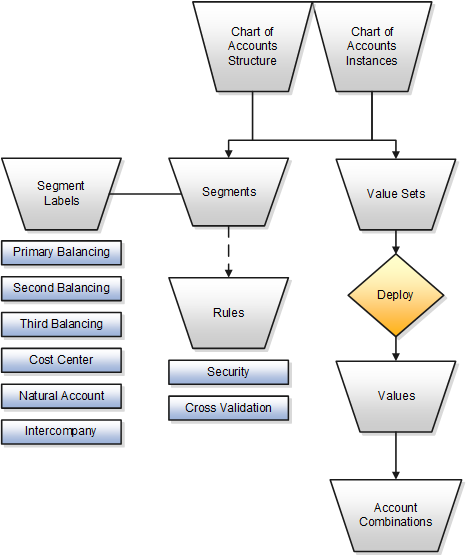Chart of Accounts Components
The important elements in a basic chart of accounts in Oracle Fusion Cloud Applications included a structure that defines the account values, segments and their labels, and rules (security and validation).
Account combinations link the values in the segments together and provide the accounting mechanism to capture financial transactions.
This figure illustrates the main components in the chart of account structure and the way they fit together. The chart of accounts consists of segments which have value sets attached to them to determine the values from each used in creating account combinations. Segments also have segment labels attached to them to point to the correct segment to use in general ledger processing, such as intercompany balancing or retained earning summarization. Segments are secured by security rules and accounts are secured by cross validation rules.

Chart of Accounts
The chart of accounts defines the number and attributes of various segments, including:
-
Order of segments
-
Width of segments
-
Prompts
-
Segment labels, such as balancing, natural account, and cost center.
The chart of accounts further defines:
-
Combination of value sets associated with each segment
-
Type of segment
-
Default values for the segments
-
Additional conditions designating the source of the values using database tables
-
Required and displayed properties for the segments
Segments
A chart of accounts segment is a component of the account combination. Each segment has a value set attached to it to provide formatting and validation of the set of values used with that segment. The combination of segments creates the account combination used for recording and reporting financial transactions. Examples of segments that may be found in a chart of accounts are company, cost center, department, division, region, account, product, program, and location.
Value Sets and Values
The value sets define the attributes and values associated with a segment of the chart of accounts. You can think of a value set as a container for your values. You can set up your flexfield so that it automatically validates the segment values that you enter against a table of valid values. If you enter an invalid segment value, a list of valid values appears automatically so that you can select a valid value. You can assign a single value set to more than one segment, and you can share value sets across different flexfields.
Segment Labels
Segment labels identify certain segments in your chart of accounts and assign special functionality to those segments. Segment labels were referred to as flexfield qualifiers in Oracle E-Business Suite. Here are the segment labels that are available to use with the chart of accounts.
-
Balancing: Ensures that all journals balance for each balancing segment value or combination of multiple balancing segment values to use in trial balance reporting. The three balancing segment labels are: primary, second, and third balancing. The primary balancing segment label is required.
-
Cost Center: Facilitates grouping of natural accounts by functional cost types, accommodating tracking of specific business expenses across natural accounts. As cost centers combine expenses and headcount data into costs, they're useful for detailed analysis and reporting. Cost centers are optional, but required if you're accounting for depreciation, additions, and other transactions in Oracle Assets, and for storing expense approval limits in Oracle Expenses. If you're implementing Oracle Fusion Cloud Procurement, you can use cost centers for business intelligence reporting and to route transactions for approval.
-
Natural Account: Determines the account type (asset, liability, expense, revenue, or equity) and other information specific to the segment value. The natural account segment label is required.
-
Intercompany: Optionally, assigns the segment to be used in intercompany balancing functionality.
Account Combinations
An account combination is a completed code of segment values that uniquely identifies an account in the chart of accounts, for example 01-2900-500-123, might represent InFusion America (company)-Monitor Sales (division)-Revenue (account)-Air Filters (product).
Rules
The chart of accounts uses two different types of rules to control functionality.
-
Security rules: Prohibit certain users from accessing specific segment values. For example, you can create a security rule that grants a user access only to his or her department.
-
Cross-validation rules: Control the account combinations that can be created during data entry. For example, you may decide that sales cost centers 600 to 699 should enter amounts only to product sales accounts 4000 to 4999.